Research
The Hrenya Research Group
performs theoretical, simulation, and experimental
work on a variety of complex flows involving soft
matter. The emphasis is on flows involving
solid particles. Current thrusts include
cohesion, polydispersity, and of such systems.
Below is a collage of images from some recent work;
further details and references can be found below.
| Janine Galvin
flies aboard NASA's KC-135 to study wetted
particle-wall collisions in a microgravity
environment. To achieve microgravity,
the plane flies in parabolic trajectories such
that ~2g is experienced in the upward portion
of the path (during which experiment is
readied), and ~0g is experienced in the
downward portion (during which experiment is
conducted). Due to the associated
difficulties, 40 consecutive parabolas are
flown per day, for 4 days in a row. The
plane is thus coined the "vomit comet". |
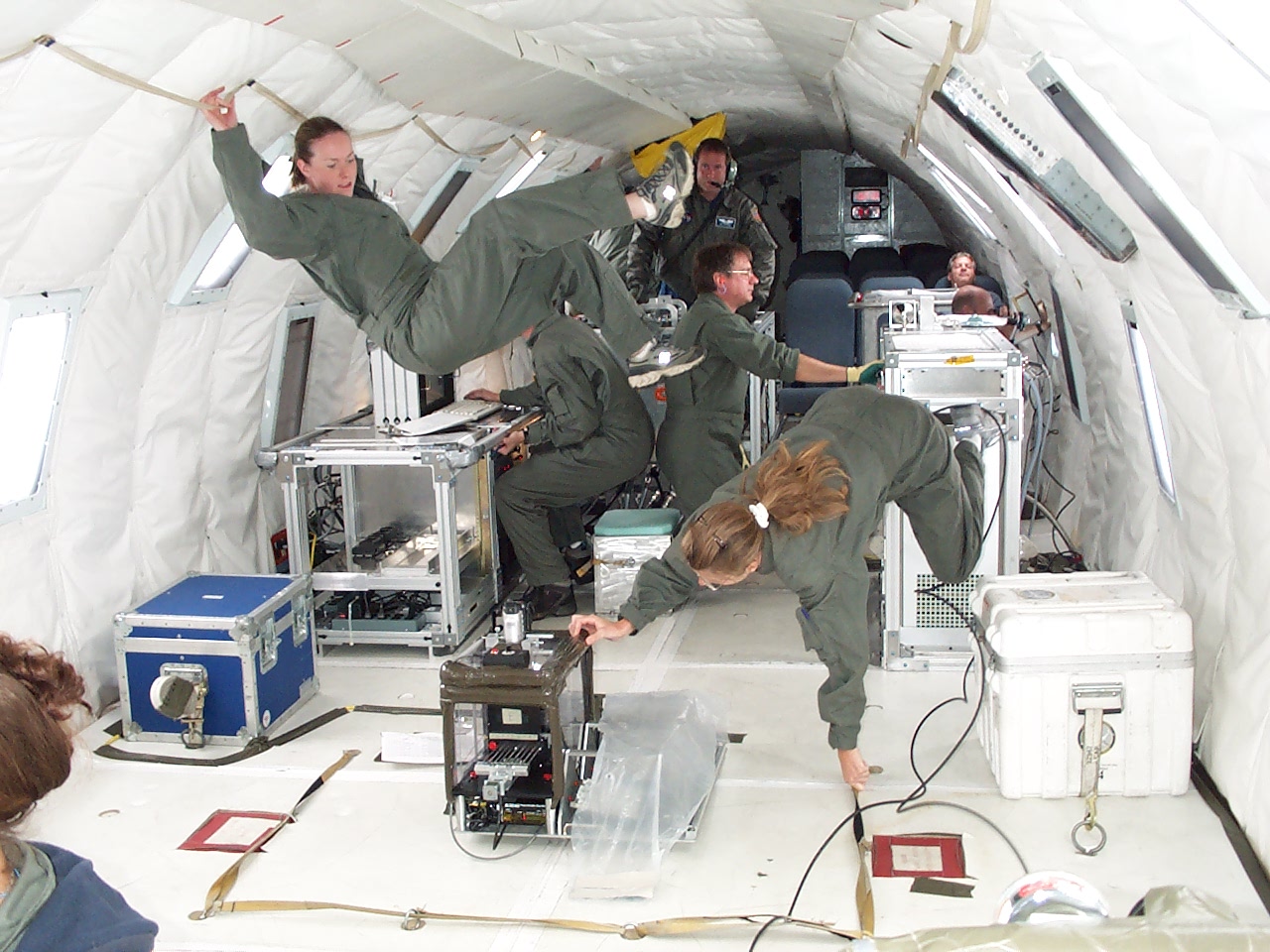
|
 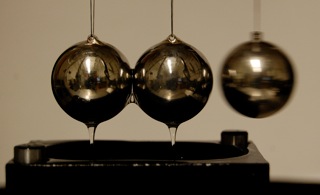 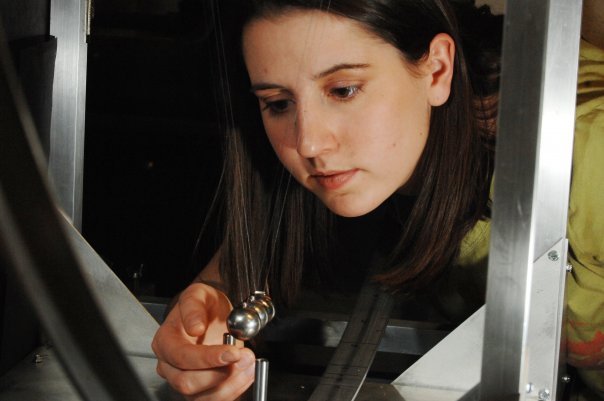 |
| In this
work, the desktop toy known as
Newton's cradle (left) is
used as inspiration for an
experimental setup (right, with
Carly Donahue) designed to
probe collisions between dry or wetted
particles [2-4]. Results from the dry
systems shed light on fundamental
differences between 2-particle and
multi-paritcle collisions, and their
associated models. In the wetted
counterpart, particles are coated with
a thin layer of viscous liquid prior
to collision (center).
This "Stokes' cradle", so coined due
to the dominance of Stokes flow in the
liquid layer, initially led to all
outcomes (fully separated, fully
agglomerated and "reverse" Newton's
cradle) except the
traditional Newton's cradle
outcome. A theoretical analysis
revealed surprising physics, which
eventually led to the experimental
discovery of the elusive Newton's
cradle outcome. |
|
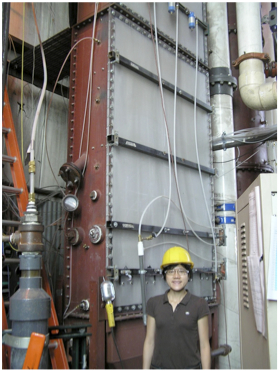 |
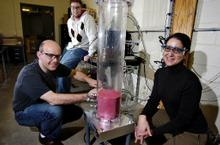 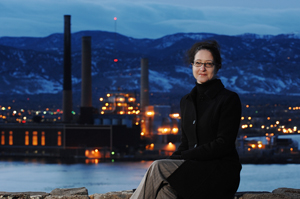 |
| Jia-Wei Chew performing
riser experimens at PSRI,
Chicago (left). Gustavo Joseph,
Joe Kozlowski, and Christine
Hrenya at the CU lab with a
fluidized bed used for
segregation experiments
(center). Christine Hrenya
in the foreground of the Valmont
Power Facility in Boulder, CO
(right). |
|
This DOE NETL-sponsored
project is targeted at the developement,
verification, and validation of first-principles
models for polydisperse, gas-solid flows, with an
ultimate goal of improving the efficiency of
gasifiers with solids feedstocks (coal, biomass,
etc.) This work, which is a collaborative
effort between Colorado, Iowa State, Princeton, and
PSRI, involves a combination of theory, simulation,
and experiments [5-10]. The resulting models
are being incorporated into the open-source
MFIX software, for availability to the greater
research community.
|
|
Molecular
dynamics (MD) simulations are a powerful
tool for understanding particulate
flows, since particle properties (e.g.,
elasticity), flow conditions (e.g., shearing
walls) and physical interactions (e.g.,
cohesion) are straightforward to
integrate. Moreover, because the paths
of individual particles are traced in both
space and time, MD is useful for simulating
the behavior of a specific system or unit
operation, and also for the testing and/or
extraction of transport coefficients for
continuum models (add ref). We have used
such simulations extensively in the study of
polydisperse systems [11-19], cohesive systems
[20-22], and Knudsen effects [23-24]. |
|
The surface of
moons and planetary bodies are covered with
a layer of fine particulates known as
regolith. When landing a spacecraft ,
the particles are ejected from this surface
due to exhaust gases from the
spacecraft. Relative to Earth, the
lack of gravity and air resistance cause the
particles to travel at extremely high speeds
and over long distances, thereby
sandblasting any nearby equipment. In
fact, back-of-the-envelope calculations
indicate that such an ejected particle cloud
may orbit the Moon entirely before settling
back onto the surface. For this
project performed in collaboration with
NASA, we are using MD simulations to
aid in the development of continuum models
for particulate material with extreme size
disparities.
|
|
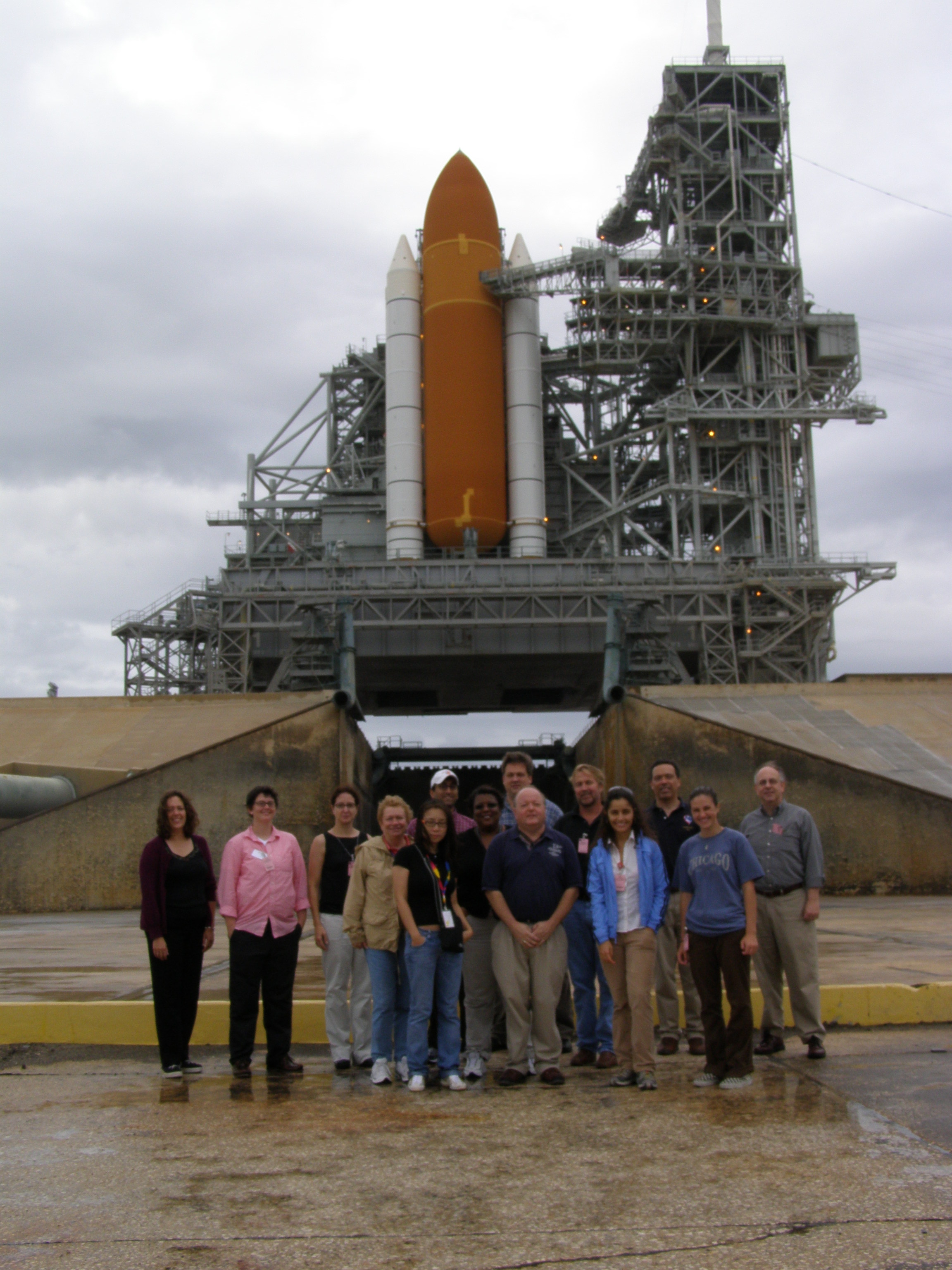
|
|
Christine
Hrenya (3rd from left)
participates in a workshop at NASA
Kennedy Space Center.
|
|
References
[1] A. A.
Kantak, J. E. Galvin, D. J. Wildemuth, R. H.
Davis, Low-velocity collisions of particles with a
dry or wet wall, Microgravity Sci. Technol.
17 (2005) 18-25.
[2] C. M.
Donahue, C. M. Hrenya, A. P. Zelinskaya, K. J.
Nakagawa, Newton's cradle undone: Experiments and
collision models for the normal collision of three
solid spheres, Phys. Fluids 20 (2008) 11.
[3] C. M.
Donahue, C. M. Hrenya, R. H. Davis, K. J.
Nakagawa, A. P. Zelinskaya, G. G. Joseph, Stokes’
cradle: Normal three-body collisions between
wetted particles, Journal of Fluid Mechanics
650 (2010) 479-504.
[4] C. M.
Donahue, C. M. Hrenya, R. H. Davis, Stokes’s
cradle: Newton’s cradle with liquid coating, Physical
Review Letters, 105 (2010) art. no. 034501.
[5] V.
Garzó, J. W. Dufty, C. M. Hrenya, Enskog theory
for polydisperse granular
mixtures. I. Navier-stokes order
transport, Phys. Rev. E 76 (2007) art. no.
031303.
[6] V.
Garzó, C. M. Hrenya, J. W. Dufty, Enskog theory
for polydisperse granular
mixtures. Ii. Sonine polynomial
approximation, Phys. Rev. E 76 (2007) art.
no. 031304.
[7] R. B.
Rice, C. M. Hrenya, Clustering in rapid granular
flows of binary and continuous particle size
distributions, Phys. Rev. E 81 9.
[8] C. M.
Hrenya, Extraction of transport coefficients from
molecular dynamics simulations: A
perspective, Industrial & Engineering
Chemistry Research 49 (2010) 5304-5309.
[9] C. M.
Hrenya, Kinetic theory for granular materials:
Polydispersity, Computational gas-solids flows
and reacting systems: Theory, methods and
practice, edition, IGI Global, Hershey, PA,
2010,
[10] J. W. Chew, J. Wolz,
C. M. Hrenya, Axial segregation in bubbling
gas-fluidized beds with gaussian and lognormal
distributions of Geldart Group B particles, AIChE
Journal (in press)
[11] R. Clelland, C. M.
Hrenya, Simulations of a binary-sized mixture of
inelastic grains in rapid shear flow, Phys.
Rev. E 65 (2002) art. no. 031301.
[12] S. R. Dahl, R.
Clelland, C. M. Hrenya, The effects of continuous
size distributions on the rapid flow of inelastic
particles, Phys. Fluids 14 (2002)
1972-1984.
[13] S. R. Dahl, C. M.
Hrenya, V. Garzó, J. W. Dufty, Kinetic
temperatures for a granular mixture, Phys.
Rev. E 66 (2002) art. no. 041301.
[14] S. R. Dahl, R.
Clelland, C. M. Hrenya, Three-dimensional, rapid
shear flow of particles with continuous size
distributions, Powder Tech. 138 (2003)
7-12.
[15] S. R. Dahl, C. M.
Hrenya, Size segregation in rapid, granular flows
with continuous size distributions, Phys.
Fluids 16 (2004) 1-13.
[16] S. R. Dahl, C. M.
Hrenya, Size segregation in gas-solid fluidized
beds with continuous particle size distributions,
Chem. Eng. Sci. 60 (2005) 6658-6673.
[17] H. Iddir, H.
Arastoopour, C. M. Hrenya, Analysis of binary and
ternary granular mixtures behavior using the
kinetic theory approach, Powder Tech. 151
(2005) 117-125.
[18] J. E. Galvin, S. R.
Dahl, C. M. Hrenya, On the role of
non-equipartition in the dynamics of
rapidly-flowing, granular mixtures, J. Fluid
Mech. 528 (2005) 207-232.
[19] R. B. Rice, C. M.
Hrenya, Characterization of clusters in rapid
granular flows, Phys. Rev. E 79 (2009)
art. no. 021304.
[20] M. W. Weber, D. K.
Hoffman, C. M. Hrenya, Discrete-particle
simulations of cohesive granular flow using a
square-well potential, Granular Matter 6
(2004) 239-254.
[21] M. W. Weber, C. M.
Hrenya, Square-well model for cohesion in
fluidized beds, Chem. Eng. Sci. 61 (2006)
4511-4527.
[22] M. W. Weber, C. M.
Hrenya, Computational study of pressure-drop
hysteresis in fluidized beds, Powder Tech. 177
(2007) 170-184.
[23] J. E. Galvin, C. M.
Hrenya, R. D. Wildman, On the role of the knudsen
layer in rapid granular flows, J. Fluid Mech.
585 (2007) 73-92.
[24]
C. M. Hrenya, J. E. Galvin, R. D. Wildman,
Evidence of higher-order effects in
thermally-driven, rapid granular flows, J.
Fluid Mech. 598 (2008) 429-450.
|
